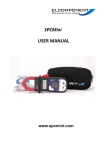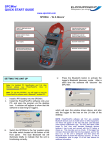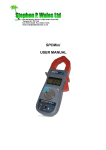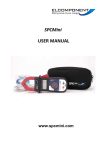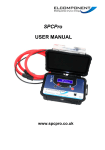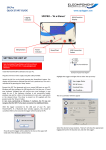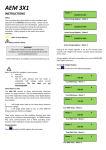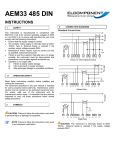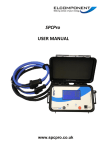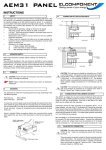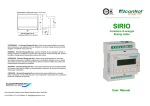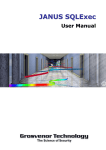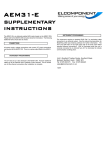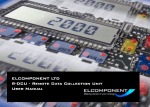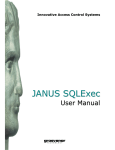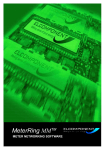Download SPCMini USER MANUAL
Transcript
SPCMini USER MANUAL www.spcmini.com SPCMini User's Guide Copyright © 2006 Elcomponent Ltd All Rights Reserved. The information in this document is subject to change without notice. Elcomponent Ltd has made every effort to ensure the accuracy of this manual. However, Elcomponent Ltd makes no warranties with respect to this documentation and disclaims any implied warranties of merchantability and fitness for a particular purpose. Elcomponent Ltd assumes no responsibility for any errors that may appear in this document. Trademarks Bluetooth® is a registered trademark of Bluetooth SIG. Inc. IBM is a registered trademark of International Business Machines Corporation. Windows is a trademark of Microsoft Corporation. All other product names are copyright and may be trademarks and/or registered trademarks of their respective companies. Symbols: The following symbols may be used in this manual WARNING: Failure to follow the instructions may result in personal injury or damage to the instrument. PC Specification: The SPCMini has a large memory capacity and also utilises Bluetooth as its communication and data transfer protocol. This requires a PC of the following minimum specification to make best use of the product’s capabilities. Windows: Processor: RAM: Display: Bluetooth: Windows XP Home or Professional Pentium 4 or Centrino mobile 2.0 GHz+ 256MB+ 32 bit colour 1024 x 768 minimum Pre-installed or via unused USB port. A lower spec PC may provide satisfactory performance, but Bluetooth pairing will take longer, and the graphing capability, particularly with larger surveys will be slower. PCs running W2000 will also function with the SPCMini and PowerPackPro, and may be used at the user’s discretion. ii CONTENTS SPCMini “At A Glance” … … … INTRODUCTION … … … … Description … … … … SETTINGS & USE … … … … Changing the Battery … … The Clip-On Ammeter … … Making Single Phase Measurements Making 3 Phase Measurements … The DataLogger … … … Switching the Unit Off … … POWERPACK SOFTWARE … … Loading the Software … … PowerPack Pro “At A Glance” … Communicating with the SPCMini Status … … … Set-Up … … … Download … … … USING THE GRAPHING PACKAGE … Selecting the Measurement Unit … Using the Graph Tools … … Chart Tab … … … Zoom … … Show Data Values … Show Alarm Values … Show Gridlines … Additional Graph Functions … Export to Microsoft Office … Set Graph Options … … Summary Tab … … … Data Tab … … … … Selecting Data … … iii … … … … … … … … … … … … … … … … … … … … … … … … … … … … … … … 01 02 03 04 04 05 05 07 08 09 10 10 11 12 16 16 17 19 20 20 20 20 21 22 23 23 23 23 24 25 25 Exporting Data … Statistics Tab … … Costs Tab … … … Adding & Amending Tariffs Alarms Tab … … … BLUETOOTH TROUBLESHOOTING Installing Bluetooth on your PC iv … … … … … … … … … … … … … … 25 25 26 26 27 28 28 SPCMini - ‘At A Glance’ 1 INTRODUCTION The SPCMini and its dedicated PC software package ‘PowerPackPro’ combine new technology and years of experience into an unbeatable low-cost package. It has a large clear display, a massive ‘Flash’ memory, and set-up and data download is via an integrated Bluetooth communication chip, compatible with virtually any PC running Windows. The SPCMini is also extremely versatile and will provide accurate results on loads as small as 1 amp, right up to a maximum of 600 amps. The logging interval is fully adjustable from 1 second all the way to 30 minutes for ultra-long-term surveys. The SPCMini is easy to use – clip it on, check the load with the onboard display, set it to log, press the start button and you’re done! It’s also clever – it won’t overwrite any previous surveys without warning you, and the logger electronics auto-ranges to ensure the highest levels of measurement accuracy at all times. Connection to the PC is via Bluetooth – just like a mobile phone – so there’s no need to plug cables into hard to reach sockets. The ‘PowerPackPro’ PC software package has been developed specifically for the SPCMini and is streets ahead of the competition. Designed by Mike Matthews, the architect of our acclaimed MeterRing MM aM&T package it combines outstanding ease-of-use with many powerful features for effective energy management. 2 DESCRIPTION The SPCMini combines the functions of a clip-on ammeter for measuring AC current, with a sophisticated data logger to record the measured current at the desired storage interval. The unit contains a Bluetooth communications module which provides wireless communication to any Bluetooth equipped PC running Windows XP, allowing the user to set up and download the logger via the PowerPackPro utility software supplied with the SPCMini. The SPCMini features simple controls (see ‘At A Glance ‘ on page 1) and may be used either as a simple clip-on ammeter or as a datalogger, as detailed below. 3 SETTINGS & USE CHANGING THE BATTERY The SPCMini is powered by a PP3 type 9VDC alkaline battery (Duracell MN1604 or equivalent). The battery powers both the clip-on ammeter display and the datalogger. A fully charged battery will give many hours of display time when the SPCMini is being used as a clip-on ammeter. A low battery condition is indicated by the ‘LOBAT’ warning appearing in the bottom left of the ammeter display. 0.00 LOBAT The battery voltage is also monitored by the PowerPackPro utility software (see page 16) allowing the user to assess the battery condition prior to initiating a survey. The datalogger features extremely efficient low power circuitry as well as a totally secure memory (recorded data are not dependent on the battery condition or presence) and a fully charged battery should provide sufficient energy for a survey lasing 4 weeks or more. However, it is recommended that a new battery be installed before starting a survey. To change the battery, the cover on the back of the unit is removed using a Phillips type screwdriver. The battery is then clipped onto the terminal block, ensuring that the correct polarity is respected. Replace the cover, ensuring that no cables are trapped or misplaced. 4 THE CLIP-ON AMMETER To use the SPCMini in ammeter mode, the selector switch should be set to ‘display’ (down) and the current selector switch set for the desired range. NOTE: If the load to be measured is not known, set the unit to the 600A range and reset it as necessary WARNING: Do not alter the range setting whilst a load is being measured as this could damage the unit. Always remove the SPCMini from the cable before resetting the range switch. Clip the unit around the conductor to be measured and read the current in amps on the LCD display. WARNING: Take care when working near live parts. Ensure that the power is turned off before exposing live parts. The SPCMini should be used on insulated conductors only. MAKING SINGLE PHASE MEASUREMENTS: The SPCMini is a single input device, and is therefore suitable for the direct measurement of single phase supplies. Single phase cables in the UK will conform to the following colour codes: Installations prior to 2005/06 Live Neutral 5 Earth Installations after 2005/06 Live Neutral Earth Appliance Cables L N E In all cases, it is the ‘live’ cable only that must be measured. In the case of appliance cables this is easily achieved utilising the SPC Cable Splitter which is available as an accessory from Elcomponent. 6 NOTE: Clipping the unit around the live and neutral conductors together will not work. The SPCMini must be clipped around the live cable only. MAKING 3 PHASE MEASUREMENTS: Despite its single input limitation, the SPCMini may also be used to make measurements of 3 phase supplies as detailed below. Three phase systems in the UK will conform to the following colour codes: Installations prior to 2005/06 PH 1 PH2 PH3 N Installations after to 2005/06 PH 1 PH2 PH3 7 N As the current flowing in each of the three phases can differ it is recommended that the SPCMini be utilised in display mode to establish the actual phase loadings, and if they differ, the ‘middle’ loaded phase should be logged. Some loads such as electric motors have all three phases loaded equally. These loads are generally referred to as ‘balanced’ and can be logged using any of the three conductors. ‘Unbalanced’ loads cannot be measured 100% accurately by the SPCMini, but any inaccuracy is minimised by logging the ‘middle’ loaded phase. In all cases it is imperative that the unit is clipped around one phase only. THE DATA LOGGER To use the SPCMini as a data logger it must first be set to the desired storage interval using the PowerPackPro utility software supplied. See page 01 for details of this procedure. Switch the slide switch to ‘log’ mode (up). The ‘reset/start’ and Bluetooth l.e.d.s will illuminate briefly to indicate that the logger electronics have been initiated. NOTE: Ensure that the battery in the SPCMini has sufficient charge before starting a survey. Clip the SPCMini around the desired cable/conductor and press and hold the reset/start button until the red l.e.d. goes out to initiate logging. Refer to the ‘Clip-on Ammeter’ instructions on page 5 for further details on installing the unit onto a conductor. 8 NOTE: The red ‘Log on’ l.e.d. will behave differently depending on the memory status of the logger. If the logger memory already contains data that have not been downloaded the l.e.d. will warn by flashing quickly. Releasing the button whilst the l.e.d. is still flashing will retain the data, allowing the user to download it before proceeding. If the button is pressed and held for approximately 5 seconds the l.e.d. will cease flashing, any existing data will be erased and a new survey will commence. This is indicated by the l.e.d. producing a short flash every 5 seconds whilst logging is taking place. If there are no unrecovered records in the logger memory the l.e.d. will respond by illuminating for approximately 2 seconds before logging is initiated. Check the l.e.d. is showing a short flash every 5 seconds to verify that logging is actually enabled. If the storage period is set to less than 5 seconds, the l.e.d. will flash each time a record is stored. NOTE: The display does not function in ‘log’ mode, and the rotary ‘range switch’ is inoperative. It is not necessary to select a range as the datalogger is fully auto ranging and will provide maximum accuracy and resolution under all load conditions. The unit may be left to complete the programmed survey, at which point the logger will enter a dormant mode, or the survey may be downloaded/terminated at any point. For instructions on downloading the SPCMini, refer to page 17. SWITCHING THE UNIT OFF When not in use the SPCMini should be switched ‘off’ using the slide switch (middle position). This will switch off both the display and the datalogger to preserve the battery. NOTE: Any data stored in the datalogger will not be lost when the unit is switched off. They are retained for future download. 9 POWERPACKPRO SOFTWARE OVERVIEW The SPCMini is shipped complete with a dedicated PC utility program which provides communication, set up and data presentation capabilities. PowerPackPro is designed to run on Windows XP, but may also be used on W2000 platforms. PowerPackPro is a task-orientated program and is extremely easy to drive, even for new users. LOADING THE SOFTWARE PowerPackPro uses Bluetooth wireless technology to connect to the SPCMini, which means no cable connection is necessary or available for the SPCMini. Before loading PowerPackPro it’s important to establish if your PC has Bluetooth installed. (See page ii for recommended PC specification). If your PC has Bluetooth already installed, it should not require any additional configuration to work with the SPCMini & PowerPackPro. See the troubleshooting guide at the back for this user manual for further information on Bluetooth issues. If your PC does not have Bluetooth installed, an accessory kit is available form Elcomponent which includes a plug-in Bluetooth USB module. Alternatively, Bluetooth modules are available from your PC supplier. Please refer to the documentation included with your Bluetooth hardware for installation instructions, which is normally a simple ‘Plug and Play’ procedure. To load PowerPackPro install the CD and follow the on-screen instructions. NOTE: PowerPackPro is available for free download www.spcmini.com. Check the website for free upgrades! 10 at POWEPACKRO – ‘AT A GLANCE’ Main Toolbar Bluetooth Network Tree Data Presentation Window List of downloaded Surveys 11 COMMUNICATING WITH THE SPC MINI Click the desktop icon to open PowerPackPro. The software will automatically open the ‘Searching for Loggers’ dialog box. Switch the SPCMini to ‘log’ and press the Bluetooth button to enable discovery. NOTE: The Bluetooth l.e.d. will come on and remain illuminated for approximately 20 seconds to indicate that the unit is in ‘discovery’ mode. If the SPCMini has not linked to the PC within this time, press the Bluetooth button a second time to re-enable discovery. After approximately 10-20 seconds, the software should find the logger and establish a connection with it. This is confirmed by the window shown below: 12 NOTE: The SPCMini will also appear on the device tree when it links to the host PC. You may also see other Bluetooth devices appearing (usually mobile phones) and these may be found more quickly than the SPCMini. This is normal, and a function of the fact that the SPCMini and PC must ‘find’ each other, then ‘pair’ with each other, and finally set up a communication link before the device is confirmed as linked. Once the SPCMini appears on the tree, it will remain connected to the PC for a maximum of 20 seconds unless a dialogue box is present on the desktop to maintain device communication. If the SPCMini disappears, the ‘search’ mode must be restarted using the top left of the icon bar. button If the software does not find any Bluetooth devices, you may have a Bluetooth module that is not compatible with this function in PowerPackpro. Normally, this incompatibility is easy to spot, as the Bluetooth icon will not appear in the device tree. If this happens, it is necessary to approach the initial logger connection slightly differently. Close PowerPackPro, and utilise the Bluetooth utility already present on the PC to search for available 13 devices. The Utility is usually opened via a Bluetooth icon in the System Tray at the bottom right hand side of the PC screen, although it may also appear as a desktop icon or as a ‘Bluetooth Services’ icon in the Control Panel. If the Bluetooth function is working on your PC, the utility search will find any available devices including the SPCMini which will appear in a window similar to that shown below: Highlight the SPCMini and click ‘next to proceed. The Utility will allocate a COM port to the device, which is confirmed by the following screen: 14 Click ‘next’ to display the available devices and/or close the utility. At this point some utilities allow the user to specify an action to be completed after the connection is made. If this option exists, specify the opening of: C:\ProgramFiles\Elcomponent\PowerPackPro\PowerPackPro.exe as the desired action. PowerPackPro will then open automatically whenever an SPCMini Bluetooth connection is established. Re-open PowerPackPro, noting that the available COM ports will appear on the tree, including the port that has been allocated to the SPCMini. Right click on this port and select ‘Discover Logger’. This will add the SPCMini to the tree and open the dialogue window as shown on page 13. NOTE: The Bluetooth Utility supplied with your PC may differ in detail from that shown above, but the principle remains the same. If PowerPackPro does not show a Bluetooth icon on the tree, and does not find the logger, use the utility preloaded onto your PC to establish a link with the SPCMini, and to allocate a COM port to it. 15 This provides three options: Status (also available via the icon) Battery Voltage should read over 7.5V. If the reading is lower than this, replace the battery. Serial number/Logger Name shows the logger serial number by default. This can be changed to reflect your desired name (up to 14 characters). The status window will show a red bar if logging is ‘off’, green if it is ‘on’. Setup (Also via icon) 16 Use this window to set the desired data storage interval/survey period. Note that a 1 minute interval provides a survey length of approximately 91 days. A fully charged battery will provide a minimum of 30 days logging. When the ‘set logger’ button is pressed, the unit will be updated with the desired storage interval and the logger clock will be set to the PC clock time. NOTE: Ensure your PC clock time is correct! Download (also available via icon) Check that the logger shown in the ‘available loggers’ window matches the logger you wish to download, or select an alternative if multiple loggers are available. STEP 1 Click ‘next’ to download the data (this does not clear the logger memory. This is only done via the reset/start button on the logger). STEP 2 Click ‘next’ to enter the survey name, location and any relevant notes. 17 STEP 3 Select ‘1 phase’ or ‘3 phase’ to match the survey supply type. NOTE: If the supply type is set to 3 phase, PowerPackPro will assume a balanced load condition. See page 7 for more details on making 3 phase measurements. STEP 4 Enter the supply voltage as a phase to neutral value. If the survey was carried out on a 3 phase 3 wire system (where no neutral is present) it is necessary to enter the value from phase to earth. STEP 5 Select a load type, or enter the power factor of the load if known. STEP 6 If an additional CT was used its ratio can be entered at this point. STEP 7 Select a tariff from the drop down menu for use in cost calculations. NOTE: PowerPackPro is pre-loaded with default single rate and day/night tariffs. Other tariffs may be added by the user (see page 26). Click ‘finish’ to open a graph showing the survey results 18 USING THE GRAPHING PACKAGE PowerPackPro will automatically open a graph after a survey has been successfully downloaded. Graphs may also be opened by clicking on the relevant survey in the survey list, or via the icon. The default graph settings will create a graph using a 30 minute data interval with an initial view of a 1 week period. PowerPackPro is shipped with two sample surveys pre-loaded. Survey 1 is used in the following pages. The above window shows the default view for survey 1. 19 SELECTING THE MEASUREMENT UNIT Click the drop-down list on the toolbar to select the desired unit. NOTE: The Energy/Power/Cost values are defined by the values entered by the user at the download stage. See page 26 for details on editing these values. NOTE: The graph uses a line chart for amps and kW and a bar chart format for the derived values of kWh and cost. USING THE GRAPH TOOLS Chart Tab: Zoom: Click the zoom tool buttons to activate the zoom cursor. Drag the cursor over the desired graph area whilst holding down the left mouse button to define a zoom area. 20 Release the mouse button to display the zoom area NOTE: The zoom function can be repeated as many times as necessary to provide a macro zoom capability. The button reverses the zoom-in process one step per click. Show Data Values: Click the crosshairs button to enable this feature. Place the crosshairs at any point on the data trace to display the value and time stamp below the title bar. Double click on the trace to display this information on the graph itself. 21 To remove data values from the graph, re-select the cursor. Show Alarm Levels: Click the button to display the alarm values on the graph. See page 27 for information on setting alarms. 22 Show Gridlines: Click the button to toggle the graph gridlines on and off. ADDITIONAL GRAPH FUNCTIONS Export to Microsoft Office: Excel or Word buttons on the main toolbar to export Click the the graph image to either of these programs. (This can also be done using the ‘Edit/Select All’ function on the menu bar or from the graph toolbar icon , and copy and paste buttons on the toolbar). Set Graph Options: The graph may be adjusted to reflect the survey parameters and the desired presentation. Select Tools/Options from the main menu bar to open the options window. Set the analysis data interval and initial chart view to match the desired presentation. 23 SUMMARY TAB: Click the ‘summary’ tab at the bottom of the chart window to open the survey summary page. The following fields may be edited as required. • • • • • Title Location Created By Voltage Power Factor The ‘supply’ field may be changed from Single Phase to ThreePhase or vice versa via the drop down menu. Notes may be added as desired. Note that any changes made are indicated by the text changing from black to red. The option to save changes appears when exiting from the summary page. Click ‘yes’ to save changes. 24 DATA TAB: Click the ‘Data’ tabs to display the survey data in tabular format. Note that the data will match the graph period selected. If the graph is ‘zoomed in’ the data will be also. Selecting Data: Hold down the left mouse button and drag the cursor to select data. The select all data click the “Edit/Select All’ button on the main menu bar. Selected data may be copies and pasted as required using the relevant buttons on the main toolbar. Exporting Data: Data may be exported in tabular form the Excel or Word by clicking the relevant buttons on the main toolbar. STATISTICS TAB: Click the ‘statistics’ tab to display the stats window. 25 COSTS TAB: Click the ‘costs’ tab to display the costing window. PowerPackPro is supplied with two preloaded tariffs (Default Single Rate and Default Day & Night Rate). These are provided as examples and do not necessarily reflect actual tariffs. ADDING AND AMENDING TARIFFS: PowerPackPro supports the entry of multiple tariffs with up to 5 time bands. To amend an existing tariff overtype the description field as required and enter the desired cost rates also. Note that costs are entered as P/kWh. Select the desired start/finish times from the drop-down menu. Amended values will change from black to red. Click the ‘recalculate’ button to apply the revised rates to the survey data. To create a new tariff, proceed as above, adding additional bands if required. The option to save changes appears when exiting from the costs page. Click ‘Yes’ to save changes. Enter a new tariff name in the ‘Save Tariff As’ box to create a new tariff, save as the existing name to amend a tariff. 26 ALARMS TAB: Click the Alarm tab. Select the desired parameter from the drop-down menu at top left. Enable high and low alarms via the checkboxes provided. Enter your desired alarm thresholds as required and press the ‘enter’ key to activate. The alarm events will be listed in the main window. NOTE: Alarm thresholds may also be viewed on the chart, with the alarm zones appearing in pink (see page 22). 27 BLUETOOTH TROUBLESHOOTING INSTALLING BLUETOOTH ON YOUR PC The SPCMini requires a Bluetooth enabled PC preferably running Windows XP. If your PC does not have Bluetooth an accessory kit is available from Elcomponent which includes a Bluetooth USB ‘dongle’. Alternatively, a Bluetooth kit is readily available from your PC Supplier. If a few rules are observed during the installation of your Bluetooth kit, you should experience no problems communicating with your SPCMini. Bluetooth Dongles are supplied with a CD of associated drivers etc. ALWAYS run the set-up program on this CD even if you have installed the dongle and Windows advises that it is ready for use. This will install additional files that may be necessary for your Bluetooth hardware to work correctly with the SPCMini. If you experience problems install the CD a second time. TROUBLESHOOTING The SPCMini and its associated software package PowerPackPro have been extensively tested with a variety of PC and Bluetooth combinations, and have been found to work reliably in most cases. However, the Bluetooth interface is a developing field, and new combinations of hardware and software are always possible. The following pages will provide some valuable tips on how to obtain the best performance from your SPCMini Bluetooth communication. If your are experiencing problems communicating with your SPCMini, check the following items first: • Shut down any other programs that may be running as these may involve processes that interfere with Bluetooth. 28 • Check if you can ‘see’ the SPCMini using the Bluetooth Utility on your PC. This is usually opened via a Bluetooth icon in the System Tray at bottom right of your PC screen, but may also be accessed via a desktop icon or an icon in Control Panel. If the SPCMini is found via your Bluetooth Utility, but not via PowerPackPro, refer to page 13 for detailed instructions on how to proceed. • Check that Bluetooth is enabled on your PC. Click ‘Start’ / ‘Control Panel’ and note whether the Bluetooth icon appears in your control panel window. If it is present this means Bluetooth has been loaded onto your PC, but may not be correctly enabled. • If it is present but not working, click the system icon and select ‘Hardware’/‘Device Manager’. Check that the Bluetooth icon appears on your device list. • If it does not, or if it appears with a red X or yellow exclamation mark ! Bluetooth is not enabled. • If your Bluetooth uses an external USB ‘Dongle’ make sure it is plugged in. Most dongles have an on-board activity l.e.d. 29 If this does not show any signs of life when plugged in, the dongle may be faulty. • If your PC is fitted with Bluetooth as standard it (does not require any external dongle) check that it is enabled. This may require you to enter the ‘Set-up’ routine of your PC, and may not necessarily be a ‘windows’ operation. Refer to your PC documentation for more assistance. • Check whether PowerPackPro or your Bluetooth Utility can ‘see’ any other Bluetooth devices in range of the host PC such as mobile phones, PDAs etc, as these will appear on the devices tree in PowerPackPro or in the device list in your Bluetooth Utility. • If either software ‘finds’ other Bluetooth devices, the problem may be with the SPCMini itself. • If Bluetooth communications become erratic or slow, reboot your PC to re-initialise the Bluetooth device. 30 Unit 5 Southmill Trading Centre, Southmill Road, Bishoop’s Stortford, Herts. CM23 3DY 01279 503173 [email protected] www.elcomponent.co.uk www.spcmini.com 31



































